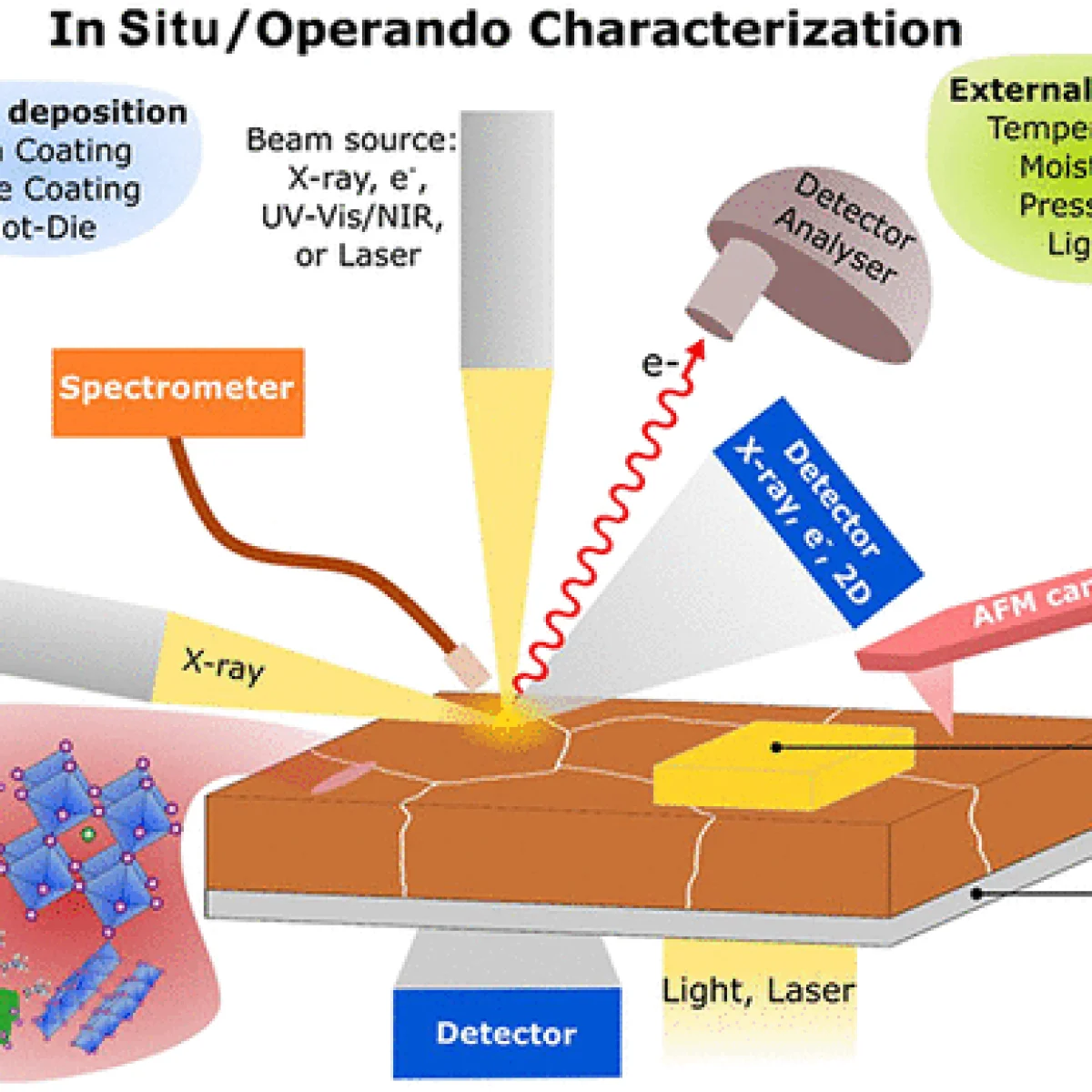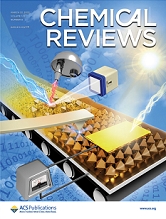
Review article was highlighted in Chemical Reviews magazine
Originally published by CINE (Center for Innovation on New Energies)
A body of recent research is accelerating the development of perovskite solar cells. These studies monitored, in real time and in detail, the changes that occur in perovskite films during processes that influence their early degradation – one of the main obstacles to the commercialization of this emerging photovoltaic technology.
The studies, several of which were carried out in Brazil in the context of CINE, are based on the use of characterization techniques called “in situ” and “operando”. Generally speaking, in situ experiments involve studying perovskite films while they are being formed, without removing them from their synthesis environment. Operando experiments, on the other hand, refer to the study of these films inside a solar cell in operation. Both types of techniques provide valuable information to improve perovskite properties and solar cell performance.
A review article on this subject was recently published and highlighted on the cover in Chemical Reviews, a scientific journal with a very high impact factor (72.087) edited by ACS Publications. Signed by a team of researchers from Unicamp, LNLS – CNPEM, CTI Renato Archer (institutions located in Campinas, Brazil) and University of Colorado (USA), the article reports the results achieved so far with the use of various in situ and operando techniques in the study of perovskites. The authors show how these scientific advances accelerated the development of technology, even making it possible to produce perovskite films from manufacturing techniques that can be taken to an industrial scale. In about three weeks since it was posted online, the review, which is 77 pages long and has 418 references, has received more than 2,300 views.
 “In this very competitive area of research, the fact that we were one of the first groups to use in situ techniques combined with synchrotron light to study perovskites was important for us to be recognized worldwide today, as attested by this publication in Chemical Review”, says Professor Ana Flavia Nogueira (Unicamp), corresponding author of the review. The scientist, who is director and researcher at CINE, has been working in the area of photovoltaic energy since her master’s degree, and she founded and coordinates the Laboratory of Nanotechnology and Solar Energy (LNES) at Unicamp.
“In this very competitive area of research, the fact that we were one of the first groups to use in situ techniques combined with synchrotron light to study perovskites was important for us to be recognized worldwide today, as attested by this publication in Chemical Review”, says Professor Ana Flavia Nogueira (Unicamp), corresponding author of the review. The scientist, who is director and researcher at CINE, has been working in the area of photovoltaic energy since her master’s degree, and she founded and coordinates the Laboratory of Nanotechnology and Solar Energy (LNES) at Unicamp.
Challenges
Perovskite solar cells have several advantages over technologies based on silicon materials, which dominate the market today. In addition to being flexible and transparent, they can be manufactured through simple processes that involve low cost and low environmental impact. First reported in 2009, the technology initially had a very low efficiency, around 4%, in converting the sun’s energy into electricity. However, thanks to scientific advances made in several laboratories around the world, efficiency has rapidly increased to exceed 25%, reaching the level of commercial solar cells in 2021.
Having overcome the challenge of efficiency, the challenge of degradation still remains, as important as the first. In fact, perovskite films, which in solar cells fulfill the function of capturing photons and transforming them into electrical charges, are materials of low stability. When films are exposed to humidity, temperature and light, their structure and composition undergo changes that impact material properties and, therefore, device performance. In other words, the films degrade and the lifetime of the solar cells is shortened. Thus, it becomes impossible to guarantee the durability of 20 or 30 years expected for a solar panel.
In recent years, scientific studies have made great strides in understanding the causes of instability and degradation of perovskites and have proposed some effective solutions to mitigate these problems. In Brazil, a series of experiments of this type were carried out from 2016 onwards, through the collaboration of a team of researchers from Unicamp and CTI Renato Archer, led by Professor Ana Flávia, with the group of researcher Helio Tolentino, from the Brazilian Synchrotron Light Laboratory (LNLS – CNPEM). The use of synchrotron radiation is, in fact, essential in this type of study, as only this light, extremely bright and capable of being condensed into nanometric foci, provides the desired level of detail.
“At the time, the synthesis routes for perovskite films were still little known and did not always generate materials with good properties”, contextualizes Tolentino. “We saw there an important niche where we could contribute by carrying out in situ experiments to observe the synthesis process in real time following all the stages of changes in the atomic structure of the material”, says the researcher.
The first Brazilian work with this approach was Rodrigo Szostak’s doctoral thesis, which was supervised by professors Ana Flavia and Tolentino. To carry out the experiments, the team had to develop a system that reproduced all the conditions for the synthesis of perovskite films in a beamline at LNLS, which at that time was still working with UVX (the second-generation light source inaugurated in 1997 ). “Overcoming the complexity of associating this synthesis process in a beamline resulted in a series of publications in excellent journals and contributed to leveraging many other issues related to the material”, says Tolentino.
“Our group’s collaboration with LNLS continues now with operando techniques”, says professor Ana Flavia. “We are going to place the solar cell on the beamline and study the behavior of the perovskite film inside the device in operation”, she completes. These new works will be carried out with even more intense and focused radiation than that used with in situ techniques. This new light comes from Sirius, the fourth-generation synchrotron source.
Sirius promises even more detailed results, but it also brings new problems to solve. “The very intense brightness of the source brings enormous additional challenges”, says Tolentino. “One example is the high dose of radiation that materials absorb, which requires a specific study before actually trying to understand the behavior of the material and the device under operating conditions”, completes the researcher.
According to the article published in Chemical Reviews, the results of the in situ studies carried out so far allowed the development of procedures that improved the quality and properties of perovskites, and made it possible to make adjustments to scalable manufacturing methods. In turn, the operando experiments allowed exploring the performance and degradation of perovskite solar cells when subjected to different operating conditions, such as high humidity, temperature or luminosity.
At the end of the review, the authors point out some ways for future in situ and operando studies of perovskite films and solar cells. According to them, it is necessary to expand the use of these techniques and combine them with computational simulations until finding materials with the best compositions and devices with the best architectures for photovoltaic energy generation. In addition, the article suggests to researchers in the field the development of in situ methods that can operate under ambient conditions to be used in quality control in future perovskite solar cell factories.
The studies carried out in Brazil were financed by FAPESP, Shell and CNPq, and had strategic support of ANP.
Scientific article reference: In Situ and Operando Characterizations of Metal Halide Perovskite and Solar Cells: Insights from Lab-Sized Devices to Upscaling Processes. Rodrigo Szostak, Agnaldo de Souza Gonçalves, Jilian Nei de Freitas, Paulo E. Marchezi, Francineide Lopes de Araújo, Hélio Cesar Nogueira Tolentino, Michael F. Toney, Francisco das Chagas Marques, and Ana Flavia Nogueira. chem. Rev. 2023, 123, 6, 3160–3236. https://doi.org/10.1021/acs.chemrev.2c00382.
Authors of the paper, members or former members of CINE: Rodrigo Szostak, Agnaldo de Souza Gonçalves, Jilian Nei de Freitas, Paulo E. Marchezi, Francineide Lopes de Araújo, Francisco das Chagas Marques and Ana Flavia Nogueira.
Experiment carried out on Sirius shed light on reaction fundamental to the production of hydrogen fuel
The first scientific paper published with data obtained at the EMA beamline studied the relationship between skutterudite’s superconducting properties and the distance between their atoms.